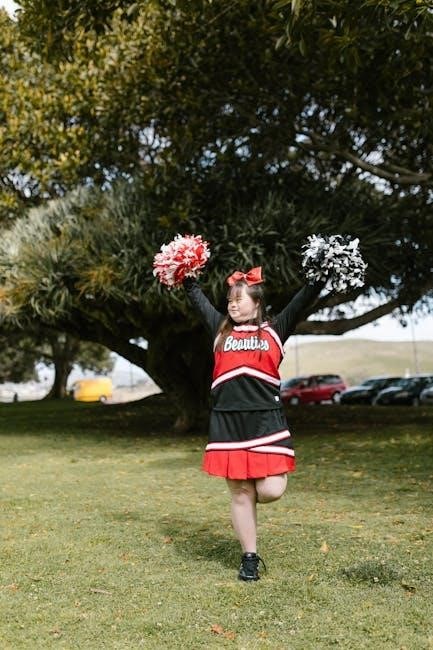Written by Anne Fadiman‚ this book explores the cultural clash between the Hmong family of Lia Lee and the American medical system. It highlights the deep spiritual beliefs of the Hmong people and their understanding of illness‚ contrasting it with Western medical practices. The story of Lia‚ a young Hmong girl with epilepsy‚ reveals the challenges of cross-cultural healthcare and the importance of understanding diverse beliefs in medical settings. The book has become a landmark in discussions about cultural competence in medicine.
Overview of the Book and Its Author
Written by Anne Fadiman‚ a renowned journalist and author‚ The Spirit Catches You and You Fall Down is a compelling narrative that delves into the complexities of cultural differences in healthcare. Published in 1997‚ the book tells the true story of Lia Lee‚ a Hmong girl with epilepsy‚ and her family’s struggles within the American medical system. Fadiman’s meticulous research and sensitive storytelling shed light on the challenges of cross-cultural communication‚ making the book a landmark in discussions about cultural competence and medical ethics. Her work has received widespread acclaim for its thought-provoking insights.
The Central Theme: Cultural Collision in Healthcare
The book centers on the profound cultural clash between the Hmong community’s spiritual beliefs and the Western medical system. The Lee family’s understanding of Lia’s epilepsy as a spiritual condition contrasts sharply with the medical professionals’ scientific approach. This collision highlights the challenges of navigating healthcare across cultural divides‚ where differing worldviews lead to misunderstandings and miscommunication. Fadiman illustrates how these disparities can impede effective treatment‚ emphasizing the need for cultural sensitivity and collaboration in healthcare settings. This theme underscores the complexities of providing care in a multicultural society.

The Hmong Culture and Spiritual Beliefs
The Hmong people deeply believe in a spiritual worldview where the soul plays a central role in health and identity. Their traditions emphasize maintaining spiritual balance‚ as the soul’s wandering can lead to illness and misfortune. This belief system‚ passed down through generations‚ shapes their understanding of the world and their approach to healing‚ often blending spiritual rituals with practical remedies. The Hmong culture’s richness lies in its vibrant spiritual practices and strong communal ties.
The Role of Spirituality in Hmong Traditions
Spirituality is central to Hmong traditions‚ with a deep belief in the soul’s role in health and identity. The Hmong believe that the soul can wander‚ causing illness or misfortune‚ and that spiritual balance must be maintained through rituals and offerings. Shamans‚ or spiritual healers‚ play a vital role in diagnosing and treating ailments by communicating with spirits. This spiritual framework influences every aspect of life‚ from birth to death‚ and is often intertwined with natural healing practices. The Hmong’s strong spiritual beliefs reflect their rich cultural heritage and communal bonding.
Hmong Views on Illness and Healing Practices
The Hmong view illness as a spiritual matter‚ often caused by soul loss or imbalance. Shamans play a crucial role in diagnosing and treating ailments through rituals and communication with spirits. Healing practices frequently involve natural remedies and ceremonies to restore spiritual harmony. The Hmong prefer these traditional methods over Western medicine‚ which they sometimes view with skepticism. This cultural approach to health emphasizes the interconnectedness of the spiritual and physical worlds‚ reflecting a holistic understanding of well-being that differs significantly from Western biomedical models. Their beliefs highlight the importance of addressing both body and spirit in healing.

The Story of Lia Lee
Lia Lee‚ a young Hmong girl‚ faces a severe epilepsy diagnosis‚ highlighting the profound cultural and medical conflicts between her family and American healthcare providers.
Lia’s Diagnosis and Medical Challenges
Lia Lee was diagnosed with severe epilepsy‚ a condition her Hmong family believed was spiritual‚ caused by her soul being caught by spirits; American doctors focused on medical treatments‚ prescribing anti-epileptic drugs‚ but cultural misunderstandings led to challenges. The Lees struggled with the side effects of medication‚ fearing it harmed Lia more than helped. Communication barriers between the family and healthcare providers exacerbated the situation‚ leading to inconsistent treatment adherence. Lia’s condition worsened‚ highlighting the clash between Western medicine and Hmong spiritual beliefs‚ ultimately resulting in devastating consequences for her health and well-being.
The Lee Family’s Perspective on Lia’s Condition
The Lee family viewed Lia’s epilepsy as a spiritual matter‚ believing her condition resulted from her soul being “caught” by spirits. They saw it as both a curse and a blessing‚ indicating Lia was special and close to the spiritual world. Hmong traditions emphasized spiritual healing through rituals and shamans‚ rather than Western medicine. The family struggled with the medical system’s focus on physical treatments‚ fearing the prescribed drugs would harm Lia. Their belief in spiritual causes led to misunderstandings and reluctance to adhere to medical advice‚ highlighting the deep cultural divide in understanding illness.

The American Medical System’s Response
The medical system focused on controlling Lia’s epilepsy with drugs and surgery‚ viewing it as a neurological disorder. This approach clashed sharply with the Hmong spiritual beliefs‚ leading to communication issues and mistrust between the family and healthcare providers.
Western Medicine’s Approach to Epilepsy
Western medicine views epilepsy as a neurological disorder requiring pharmacological and surgical interventions. Doctors emphasized controlling seizures with prescribed medications‚ expecting strict adherence. This approach prioritized scientific evidence over spiritual interpretations‚ creating tension with the Hmong belief system. The medical system struggled to reconcile its biological focus with the Lees’ spiritual understanding‚ leading to misunderstandings and resistance. The clash highlighted the challenges of integrating medical treatments with deeply held cultural and religious beliefs‚ ultimately impacting Lia’s care and outcome.
Communication Barriers Between Doctors and the Lee Family
Significant communication barriers existed between Lia’s doctors and her family‚ rooted in language differences and cultural misunderstandings. The Lees‚ Hmong refugees‚ often required interpreters‚ which were not consistently provided. Medical explanations were frequently lost in translation‚ leading to confusion and mistrust. Hmong beliefs about illness‚ tied to spiritual forces‚ clashed with the medical team’s biological explanations. This disconnect hindered effective treatment and fostered mutual frustration. The lack of clear communication exacerbated the cultural divide‚ ultimately affecting Lia’s care and highlighting the need for better cross-cultural understanding in healthcare settings.

Cultural Misunderstandings and Their Consequences
Cultural misunderstandings between the Hmong and Western medicine led to mistrust and miscommunication‚ exacerbating Lia’s condition and highlighting the profound impact of clashing beliefs on healthcare outcomes.
Differences in Perceptions of Illness and Treatment
The Hmong viewed Lia’s epilepsy as a spiritual condition‚ believing her seizures were evidence of her role as a spiritual leader. They saw Western medicine as potentially harmful‚ while doctors viewed her illness through a biomedical lens‚ emphasizing pharmaceutical treatment. This clash in perceptions led to conflicting approaches to her care. The Hmong believed that spiritual healing through rituals and shamans was essential‚ while the medical team focused on controlling her seizures with medication. These differing views created significant barriers to effective treatment and mutual understanding.
The Impact of Cultural Clashes on Lia’s Care
The cultural divide between the Hmong and Western medical perspectives severely impacted Lia’s treatment. The Hmong believed her seizures were spiritual‚ caused by her soul’s calling‚ while doctors focused on controlling symptoms with medication. This misunderstanding led to mistrust and non-compliance‚ as the Lees viewed Western treatments as harmful. Communication barriers worsened the situation‚ resulting in ineffective care and prolonged suffering for Lia. The clash highlighted the consequences of neglecting cultural beliefs in medical practice‚ ultimately affecting Lia’s quality of life and treatment outcomes.

Ethical Dilemmas in Cross-Cultural Healthcare

The book raises profound ethical questions about balancing cultural respect with medical standards. Healthcare providers face dilemmas in honoring patient beliefs while adhering to professional obligations‚ highlighting the tension between patient autonomy and effective treatment in cross-cultural settings.
Balancing Respect for Cultural Beliefs with Medical Practices
In “The Spirit Catches You and You Fall Down‚” the clash between Hmong spiritual beliefs and Western medicine underscores the ethical challenge of balancing cultural respect with medical intervention. The Hmong view illness as a spiritual matter‚ often caused by displaced souls‚ while Western doctors focus on biological causes and treatments. This conflict highlights the tension between honoring patients’ cultural practices and providing evidence-based care. The book reveals how misunderstandings and rigid approaches can lead to mistrust and ineffective treatment‚ emphasizing the need for healthcare providers to navigate these complexities with sensitivity and open communication.
The Question of Discrimination in Medical Care
The book raises critical questions about potential discrimination in medical care‚ highlighting how cultural misunderstandings can lead to unequal treatment. The Hmong community’s spiritual beliefs often clash with Western medical practices‚ creating barriers that may result in inadequate care. The Lees’ experiences reveal how systemic biases and lack of cultural understanding can inadvertently marginalize patients from diverse backgrounds. This ethical dilemma challenges healthcare providers to reflect on whether they inadvertently discriminate by failing to accommodate cultural beliefs‚ raising important questions about fairness and equity in medical treatment.

Lessons Learned from Lia’s Story
Lia’s story underscores the necessity of cultural understanding and communication in healthcare‚ emphasizing the importance of respecting diverse beliefs to improve patient care and outcomes effectively.
The Importance of Cultural Competence in Medicine
Cultural competence in medicine is vital to bridge gaps between healthcare providers and diverse patient populations. Understanding a patient’s cultural beliefs ensures respectful and effective care‚ fostering trust and collaboration. In Lia’s case‚ the clash between Hmong spirituality and Western medicine highlighted the need for providers to adapt treatments to cultural contexts. This approach not only improves health outcomes but also addresses systemic disparities. Training healthcare professionals in cultural competence can enhance communication‚ reduce misunderstandings‚ and create a more inclusive healthcare system that values patient-centered care and respects diverse worldviews.
Challenges and Opportunities for Healthcare Providers
Healthcare providers face challenges in navigating cultural differences‚ balancing medical protocols with patients’ beliefs. Lia’s story underscores the need for providers to adapt care to cultural contexts while maintaining effectiveness. Opportunities arise through improved cultural training‚ fostering trust‚ and enhancing communication. Providers can learn to respect diverse worldviews‚ ensuring patient-centered care. By embracing these challenges‚ healthcare systems can become more inclusive and equitable‚ ultimately improving outcomes for diverse populations and bridging the gap between Western medicine and traditional practices‚ as highlighted in Lia’s journey.

Legacy of the Book
Since its publication‚ the book has significantly influenced medical education‚ emphasizing cultural competence. It remains a vital resource for understanding cross-cultural healthcare challenges and fostering empathy.
Impact on Medical Education and Practice
The book has profoundly influenced medical education by highlighting the importance of cultural competence. It is now a required text in many medical schools‚ fostering empathy and understanding among future healthcare providers. The story of Lia Lee underscores the need for clinicians to bridge cultural gaps‚ leading to more patient-centered care. By challenging traditional medical approaches‚ the book has inspired changes in healthcare curricula and practices‚ encouraging collaboration between providers and diverse patient communities to improve outcomes and satisfaction.
Public Reception and Critical Acclaim
The book received widespread critical acclaim for its insightful portrayal of cultural conflict in healthcare. Readers praised Anne Fadiman’s compassionate storytelling and her ability to bridge two worlds. The emotional depth and ethical dilemmas presented resonated with both general audiences and medical professionals. It has been recognized as a landmark work in narrative nonfiction‚ earning numerous awards and a lasting place in literary discussions. The public response highlighted the universal relevance of its themes‚ making it a cherished and thought-provoking read across diverse communities.
Lia Lee’s story underscores the profound impact of cultural misunderstandings in healthcare‚ urging compassion‚ understanding‚ and collaboration between diverse belief systems and medical practices for better patient outcomes.
Final Thoughts on the Intersection of Culture and Medicine
The story of Lia Lee profoundly illustrates the challenges of navigating cultural misunderstandings in healthcare. Her experience highlights the tension between traditional Hmong spirituality and Western medical practices‚ emphasizing the need for cultural sensitivity. The book underscores how healthcare providers must bridge gaps between diverse belief systems to deliver compassionate care. By fostering mutual respect and understanding‚ the medical community can better serve patients from all backgrounds‚ ensuring that cultural differences enrich rather than hinder treatment.
Call to Action for a More Inclusive Healthcare System
The story of Lia Lee serves as a powerful reminder of the urgent need for cultural inclusivity in healthcare. Healthcare providers must prioritize cultural competence‚ embracing the diverse beliefs and practices of all patients. By integrating cultural knowledge into medical training and fostering open communication‚ the healthcare system can better serve diverse populations. Patients deserve care that respects their identities while addressing their medical needs. This requires a collaborative effort between healthcare professionals and communities to create a system that values and honors cultural differences‚ ensuring equitable care for all.

Further Reading and Resources
Explore additional books and articles on cultural competence‚ Hmong traditions‚ and medical anthropology for deeper insights into the themes explored in Fadiman’s work.
Recommended Books and Articles on Related Topics
Online Resources for Cultural Competence in Healthcare
Explore online platforms like the National Institute on Minority Health and Health Disparities and the Culture‚ Language‚ and Health Literacy section of the Health Resources and Services Administration. These resources offer guides‚ articles‚ and training modules to enhance cultural awareness in healthcare settings. Websites such as CulturalCompetence.org provide practical tools for understanding diverse patient beliefs. Additionally‚ academic journals and blogs often feature discussions inspired by Fadiman’s work‚ offering insights into improving cross-cultural communication in medical care.
